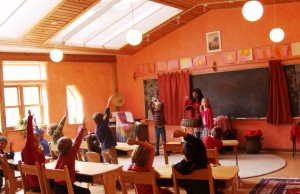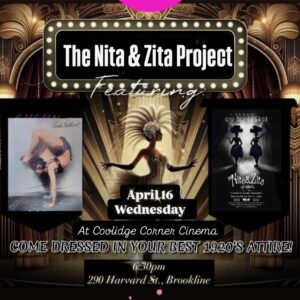Eeyore or Tigger?
Everyone seems to love neutral colors: gray, beige, off-white… but for me, neutral colors turn me into Eeyore. I feel sleepy and sad. My color tastes are more aligned with Tigger, and when I say Tigger, I mean Tigger sent bouncing into a room with a gallon of pink paint in one paw and a gallon of glitter in the other.
But is there a happy medium? What works best for kids? What enhances their learning, enriches their brain, and soothes their soul?
I started exploring this question yesterday in my never-ending quest to create the most gorgeous classroom design. I’ve been collecting various items for my future preschool for many years: hand-carved playhouses and farms, bridges, needle-felted fairy tale creatures, impossibly small acorn tea sets, and rainbow silks. Well really, silks in every color. Why?
Waldorf Color Theory for Classrooms
Because when I taught at a Waldorf preschool on Martha’s Vineyard, I followed their color protocol. The classroom was in the middle of the woods, with basic white walls, natural wood furniture, and big windows to let in nature. I wanted to paint it pink of course, which as luck would have it is the exact color Waldorf paints all their preschools and kindergarten walls, but we rented the space and weren’t allowed to paint this particular room. I hung rainbow silks from every possible place, even the ceiling, which made the room look soft and luscious.
Waldorf has many developmental theories on color, based on the color theories created by philosopher poet Goethe. I haven’t researched Goethe’s color theories, so I can’t comment on those, but I can say that Waldorf classrooms are beautiful, and they are my favorite schools to tour for design ideas. They paint in the “lazure” style, a multi-layered translucent technique of soft luminescent colors, almost like living in a watercolor. The variation seen in lazure technique is thought to stimulate and balance the activity of the eyes, providing nourishment for the soul. The idea is that with a lazure-painted room, the boundary of the wall is softened, as though one can “breathe” and not feel as bound by the walls. According to their classroom design, every age group is assigned their own colors associated with their developmental level.
The preschool/kindergarten classrooms are a warm soft pink, as they believe it is calming. When I taught Waldorf, I asked why kindergarten classrooms were all painted this color, and I was told pink is comforting to children on a subconscious level because it is the color of the womb. Okkkaaayyy… I don’t know about that, but whatever the reason, I can attest to the beauty.
When children reach the ages of 8 and 9, they often go through a developmental leap and begin to individuate, which can cause feelings of isolation and loneliness. Classrooms at this age are painted in soft rich yellows and oranges to lift the psyche. For the 4th and 5th grade, Waldorf walls are painted in shades of energetic green, and from 6th grade on, the colors become shades of blue and then violet.
I can’t claim I’ve seen miraculous effects from Lazure-painted walls, but I can attest that the paint style actually does feel nourishing to the soul, and Waldorf classrooms look extraordinary. They feel like sanctuaries amid the stress and tension of modern life.
Psychological, Emotional, and Physiological Effects of Colors in the Classroom
Psychologists have studied the impacts of certain colors on human behavior and found it has a profound effect. A recent study on classroom environment in elementary schools found that color is one of the most significant factors in student achievement. Scientists have also found unique brain activity associated with specific colors.
Most of us have seen the “traditional” elementary school classroom with bold colors, a hodgepodge of visual chaos that is overwhelming to me as an adult, but may or may not affect its actual students.Reggio Emilia and Montessori classrooms look different than traditional classrooms, with their emphasis on natural colors, simple walls, and well-organized materials.
Did you know that wall colors can influence the muscular tension and motor control of students?. Warm colors have been known to cause slight elevations in blood pressure in children, while cooler colors caused slight drops in blood pressure. Likewise, optical stimulation using warm colors and brilliance of lighting will cause increases in muscular tensions, respiration rate, heart action, blood pressure and brain activity.
Studies found that orange colors encourage creativity and enthusiasm; yellow colors evoke feelings of happiness, and summer. A little touch of orange and yellow can brighten learning environments, making it more joyful.
Cool colors and dim lighting bring about reverse effects, such as muscles relaxing more, and sleep being facilitated. In color psychology, green and blue colors connect children with nature, ocean, and sky, and give students and teachers the feelings of calmness, relaxation, trust, and safety.
We know color affects the emotions and behavior of humans: red feels energetic and pink is calming; orange and yellow are lively; green and blue bring calmness; violet feels creative; and neutrals feels… well for me it makes me feel like Eeyore but for others, it makes them feel neutral. Scientists are still investigating how and why, but there are some very interesting studies.
The Neuroscience on Colors in the Classroom
When researching the effects of color on students, I found some extraordinary information. Prepare yourself, because the following information blew my mind.
Stephen Westland, a professor and the Chair of Color Science and Technology at the University of Leeds, explains that the effects of color on humans are based on “light but not vision.”
WHAT??? I always believed colors were created by the way light waves hits our vision–no vision, no color. However, in his studies, he found that the retinal cells of the eye don’t just send signals to the visual cortex to recognize a color, but also to the hypothalamus, the part of the brain in charge of the body’s self-regulation. Incredibly, the hypothalmus is unable to recognize visual images at all. So, the brain registers color outside of vision, and it affects mood, temperature, sleep, heart rate, ability to eat and breathing patterns.
WOW!!
So how does it affect children?
In an experiment conducted by Harold Wohlfarth, published in the International Journal of Biosocial Research, he repainted an orange and white classroom in shades of blue and installed gray carpeting in place of the previous orange rug. In his experiment, all of the students’ blood pressure, respiration rates, and pulses dropped. They all became calmer, after the room makeover. Even more incredible: the study included two blind students. Although their eyes were unable to see the physical changes, their hypothalami picked up the changes in wavelengths, so they were ultimately able to reap the same benefits of those with sight.
Thinking of it this way, color seems magic.
Is Color Magic?
It wasn’t long ago they gave babies born with jaundice blood transfusions, now they lay them under a blue light to heal them. Juvenile detention centers paint rooms pink because they have witnessed the way it calms a manic or violent child. Some football teams paint the locker room of their visiting opposition pink to try to diffuse their aggression for a better chance of winning, and Tokyo’s Yamanote railway line installed blue lights at the ends of their platforms to reduce the incidence of suicide, with a 74% drop in the suicide rate after the lights were installed. Blue light is known to makes people feel more claim and less impulsive, however scientists are still researching how and why.
Color theories are extensive, and it is an interesting area to research for educators. Does it really have an impact on learning and even more importantly, quality of life? With the recent jump into online learning, could color be used to enhance learning? Online marketers use color all the time to catch attention and improve memory, so why couldn’t online teachers use color for the same reasons?
What I Know for Sure
What I know for sure is that if color can save a baby’s life, calm a violent criminal, and vastly alter my own sunny disposition into a rainy one, it makes sense that it could enhance learning for children and should be carefully considered in classroom design.
I would love to hear if others have experience with colors changing a classroom environment!






Sources:
Gruson, Lindsey. “Color Has a Powerful Effect on Behavior, Researchers Assert.” The New York Times, 19 Oct. 1982.
“The Psychology of Color.” The New York Times, 8 Jan. 2006.













